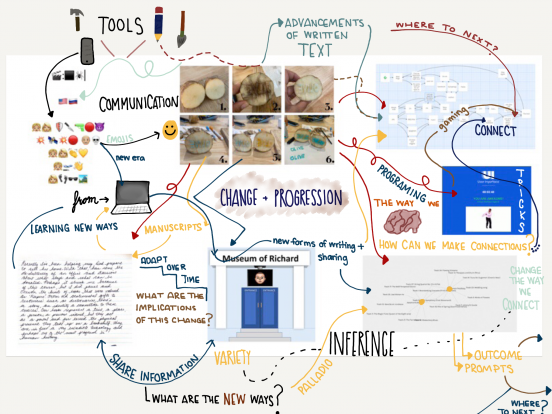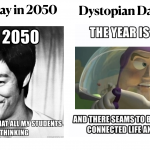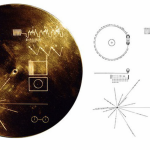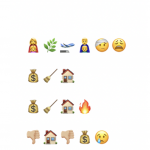Linking Assignment
In starting the linking assignment, I was having a tough time finding a common link. I would sit down at my computer and read a variety of my peer’s posts. Everyone had such different experiences with the tasks; it was hard for me to find that commonality and link them to my experience. I started by just choosing one post and relating it to mine, and it all kind of fell into place. I’ve decided to focus my linking assignment on the idea of literary change and progression, linking it to my post-Manual Scripts and Potato Printing. I have a brief write-up here for my project. However, the meat of my assignments is the visual I created, linking all the tasks to my task and theme.
1. Megan Ravenhill – Emoji Story
https://blogs.ubc.ca/mravenhill/2021/10/17/task-6-an-emoji-story/
My first link for this assignment is the post by Megan Ravenhill. The Emoji Story links to my Task Four – Manual Scripts and Potato Printing. In both posts, there is an overarching theme of change. In her post, she references Kress (2005), stating, “I was drawn to this quote from Kress (2005) because of how much change has happened since the era where writing really developed” (Ravenhill, 2021). When we think of the era where writing was developed to where we are now, the advancements are astronomical.
My potato printing post “Module 4.2 on mechanization of writing brings light to the details, extended periods, and patience required for creating scripts and writing systems. Clement describes the process of the creation of manuscript books as early as 84-86 AD. Their techniques were way more advanced than that of the potato carving. It brings light to how unbelievably far we have come as a society in the advancements of written text.”
2. Grace Reid – Manual Scripts
https://blogs.ubc.ca/ereid/manual-script-mechanization-of-writing/
The second link in my assignment is a post by Grace Reid and her interpretation of the writing of the manual script. For this task, I shied away from the thought of writing in cursive for this task as it is something that I never learned. I chose the task of carving instead. This is a part of my link as it encompasses my theme of change and progression throughout education. Thinking about writing in cursive was so foreign to me as it was a skill not taught to me in my teaching. It is no longer a part of the curriculum in British Columbia schools and is becoming a lost art, in my opinion. We have progressed from that time in history to where we now complete most written work electronically.
3. Richard – Mode Bending
The third link for my assignment was by Task 7- Mode Bending by Richard. He created a virtual museum to recreate his what’s in your bag assignment. The mode bending allowed for his assignment to have more dimension to it. The change and progression allowed more insight into his work. He did a great job of summing up the pros and cons of mode bending, which relates to my change theme.
Richard says in his post, “I decided to create a virtual museum showcasing my bag. The virtual museum gives visitors the choice to explore different items (“exhibits”) in my bag and to listen to each item tell its origin story, how I interact with the item daily, and the item’s significance is in my life. To me, the true purpose of this assignment is to help others learn more about me, what tools I need to make it through my day, and the significance of these tools, so what better to do this than to have the objects in my bag tell that story.”
4. Delian – Attention Economy
https://blogs.ubc.ca/etec540delian/2021/11/14/task-10-attention-economy/
The fourth link is from Delian’s site, task 10, attention economy. In his reflection of the task, he talks about how “we are all persuadable.” All of us are susceptible to the same influences from web designers despite our differences. We all change the way we think and view situations because of tricks they can play on us in the design of their sites. This is related to my theme of progression in how these sites are formed to change our perception of experiences.
5. Ester – Interactive Story Telling
The fifth link is from Ester’s site, task 5, interactive storytelling. She created a Twine about completing the weekly assignment. I was impressed with her Twine, as I opted out of this task because I found it challenging to navigate and found it very intimidating. I chose this to link to my potato carving because it relates to my theme of change and progression, mainly progression.
Ester said, “Okay, so here is me sitting at a table and jotting down a story line. As I normally write a rough work on paper first before start writing, I started brainstorming the big ideas using flowcharts on a notebook. Once I decided the start, choices, and the end, I started creating the story on Twine, carefully following the step-by-step manual. Creating screens, linking them using hypertexts and manipulating functions were not as complicated as I had thought they would be.”
The progression that she displayed in this Twine journey demonstrates an advance in Twine development. She went from the starting stage of brainstorming, using a notebook, to manipulating functions on the site.
6. Amy – Network Assignment
https://blogs.ubc.ca/attexttech540/2021/11/08/task-9-network-assignment/
The sixth and final link is from Amy’s post, task 9, Network Assignment. In this task, Amy talks a lot about choice and connections. “We were given the choice of 10 out of 27 items. I wonder if the same connections would be found if we could choose 10 out of 100 items or 10 out of 1,000,000 items? I am doubtful. But I do wonder, with given a larger option of tracks to choose from, how might these edges between us be the same and how might these edges be different?”






